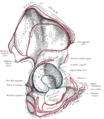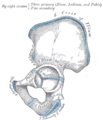Ischium
This article needs additional citations for verification. (April 2009) |
| Ischium of pelvis | |
|---|---|
Superior gemellus | |
| Identifiers | |
| Latin | os ischii |
| MeSH | D007512 |
| TA98 | A02.5.01.201 |
| TA2 | 1339 |
| FMA | 16592 |
| Anatomical terms of bone] | |
The ischium (/ˈɪski.əm/;[1] pl.: ischia) forms the lower and back region of the hip bone (os coxae).
Situated below the
Structure
The ischium is made up of three parts–the body, the superior ramus and the inferior ramus. The body contains a prominent
Body
The body enters into and constitutes a little more than two-fifths of the
Its anterior border projects as the
Above the spine is a large notch, the greater sciatic notch; Below the spine is a smaller notch, the lesser sciatic notch.
Superior ramus
The superior ramus of the ischium (descending ramus) projects downward and backward from the body and presents for examination three surfaces: external, internal, and posterior.
The external surface is quadrilateral in shape. It is bounded above by a groove that lodges the tendon of the external obturator; below, it is continuous with the inferior ramus; in front it is limited by the posterior margin of the
The internal surface forms part of the bony wall of the lesser pelvis. In front, it is limited by the posterior margin of the
Posteriorly the ramus forms a large swelling, the
Inferior ramus
The inferior ramus of the ischium (ascending ramus) is the thin, flattened part of the ischium, which ascends from the superior ramus, and joins the inferior ramus of the pubis—the junction being indicated in the adult by a raised line.
The outer surface is uneven for the origin of the
Its medial border is thick, rough, slightly everted, forms part of the outlet of the pelvis, and presents two ridges and an intervening space.
The ridges are continuous with similar ones on the inferior ramus of the pubis: to the outer is attached the deep layer of the superficial perineal fascia (fascia of Colles), and to the inner the inferior fascia of the urogenital diaphragm.
Tracing these two ridges downward, they join with each other just behind the point of origin of the transverse perineal muscles. Here, the two layers of fascia are continuous behind the posterior border of the muscle.
To the intervening space, just in front of the point of junction of the ridges, the transverse perineal attaches, and in front of this is a portion of the
Its lateral border is thin and sharp, and forms part of the medial margin of the obturator foramen.
Clinical significance
Clinically, an avulsion fracture of the ischial tuberosity may occur.[2]
Avulsion fractures of the hip bone (avulsion or tearing away of the ischial tuberosity) may occur in adolescents and young adults during sports that require sudden acceleration or deceleration forces, such as sprinting or kicking in football, soccer, jumping hurdles, basketball, and martial arts. These fractures occur at
History
Adoption of ischium into English-language medical literature dates back to c. 1640; the Latin term derives from Greek ἰσχίον iskhion meaning "hip joint". The division of the acetabulum into ischium (ἰσχίον) and ilium (λαγών, os lagonicum) is due to Galen, De ossibus. Galen, however, omits mention of the pubis as a separate bone.[5]
Other animals
Dinosaurs
The
-
Ornithischian pelvic structure (left side)
-
Saurischian pelvic structure (left side).
Additional images
-
Right hip bone. External surface.
-
Right hip bone. Internal surface.
-
Plan of ossification of the hip bone.
-
The obturator externus.
-
Pelvis
See also
References
![]() This article incorporates text in the public domain from page 234 of the 20th edition of Gray's Anatomy (1918)
This article incorporates text in the public domain from page 234 of the 20th edition of Gray's Anatomy (1918)
- ^ "ischium". The Free Dictionary.
- PMID 2380217.
- ISBN 978-1605476520.)
{{cite book}}: CS1 maint: multiple names: authors list (link - ISBN 9780071741460.
- ^ De ossibus chapter 20, ed. Kühn, vol. 2, p. 772, cited after Charles Singer, C. Rabin, A Prelude to Modern Science: Being a Discussion of the History, Sources and Circumstances of the 'Tabulae Anatomicae Sex' of Vesalius, Cambridge University Press, 1946 (reprinted 2012), p. 35.
- ^ Seeley, H.G. (1888). "On the classification of the fossil animals commonly named Dinosauria." Proceedings of the Royal Society of London, 43: 165-171.
- ISBN 1-4051-3413-5.
- Saladin, Kenneth S. Anatomy and Physiology The Unity of Form and Function. 5th ed. McGraw-Hill Science Engineering, 2009. Print.
External links
- Anatomy photo:44:st-0722 at the SUNY Downstate Medical Center - "The Male Peniel: Hip Bone"
- Cross section image: pelvis/pelvis-e12-15—Plastination Laboratory at the Medical University of Vienna








